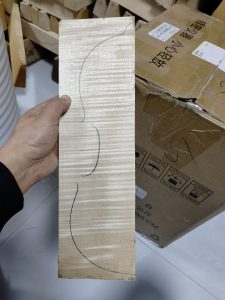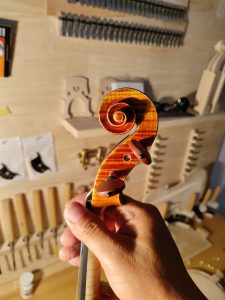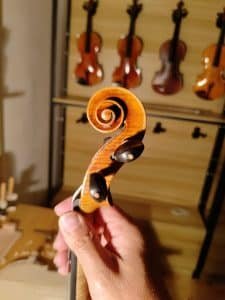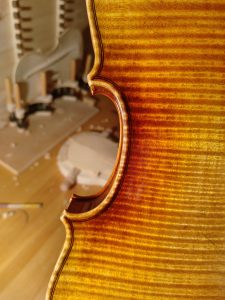Does a single-piece violin really sound better than a pieced violin?
A question often asked by string players is: "Why does the back of my violin come in two pieces, while my partner's violin has only one piece?"
In other words, is a single-back violin better than a combined-back violin?
The answer may be a bit complicated, but basically, a single board is no better than a joint.
Welcome to buy a stringed instrument from Artisan Violins, you canClick on this linkConnect with us!
The process of making a patchwork maple backboard
Most violins are made with two pieces of backing because they can be cut from a tree that is slightly wider than the instrument being made. Since there are more small trees than large trees, there are more small pieces of wood available to choose the right wood.
To make a two-piece backboard, you first need to cut a wedge-shaped piece (Example 1) from the log, like a piece of firewood. This wedge-shaped block is then cut again along the center line (Example 2), opened like a book, and the thick edges glued together to create a wide plank. The resulting backing is "quartered," where the wood grain is perpendicular to the plane of the ribs, which is its strongest and most stable orientation.
It is also "symmetrically matched," meaning the grain, pattern, and consistency of the wood are symmetrical on the left and right sides.
Single board back panel production process
A single quarter back panel is cut from a wedge of lumber wide enough to make the entire back (Example 3). This backing has the same vertical grain as the two-piece backing, but requires the use of a tree that is more than twice as wide as the instrument being made. Very few trees are wide enough to cut a single quarter cello back! Single-piece and double-piece quarter backs cut from very similar woods can be very similar in tone. However, when changing the grain direction from vertical to horizontal or "slat" cutting, a noticeable change in timbre often occurs.
The difference between a pieced violin and a one-piece violin
Batten backing is cut cross-cut through the log (Example 4), like a piece cut from a board at the lumber mill. Slatted backs tend to produce a deeper, rounder, less sharp sound. This may work well for violas and cellos, but many beautiful-sounding violins are also made from slat wood. However, slat backs are not as stable as quarter backs and typically develop more camber over time, although they still function well.
What matters is not whether the backing is made from one piece or two, but the quality of the wood. If it happens to be very beautiful, nothing is lost.
Welcome to buy a stringed instrument from Artisan Violins, you canClick on this linkConnect with us!
violin surface
Q: Why are violin tops usually made from two parts? Wouldn't a single piece top be better structurally? ——Conrad Szablewski, Flushing, New York
A: There are many reasons to use a two-piece top and back on an instrument. Most of the reasons are dictated by traditional, aesthetic and economic factors.
To keep it simple, let's just focus on the violin's top, which is typically made of spruce, a strong, lightweight wood. Its texture reflects the way the trees grow. Beginning each spring, the tree's outermost layer begins to grow, expanding the tree's girth and adding another layer of wood grain. This annual growth cycle continues until the trees are harvested. The wood grain of a violin top is perpendicular to the board when cut from a tree, often looking like thin stripes. The hard grain of the summer growth will act like the beams making the board very strong and able to withstand the pressure of the strings; however, the top will remain light and pliable due to the softer grain of the spring growth in the middle. Both of these properties are essential to a good top wood. (For more information on the properties of wood, see Bruce Hoadley, Understanding Wood (Taunton Press, 1980)).
To understand how different cuts produce different wood from a tree, imagine a log the same length as the face of a violin, standing up like a tall cake. A wedge-shaped piece of wood cut or split from a log. Split the wedge into two thinner wedges and open them at the center line like a book (hence the term "symmetrical match"). Glue these thicker (bark) sides together to make a larger board, and sand one side down. The other side of the slab will look like an extremely low roof: the peak of the slab will be the peak of the arch. This symmetrical matching method explains why tops and backs cut this way have symmetrical patterns radiating out from the central seam.
The fiddle is about eight inches wide in the lower part, so a log only needs to be about five inches to the center of the tree, or about a foot or so in diameter, to be used. Small trees that grow in the shadow of larger trees and have more detailed textures may be perfect for fiddles. When a tree is large enough (about 20 inches in diameter), a single quarter violin top or back can be cut from the tree. This size is much rarer (and more expensive) and is most often used to make two-piece cello boards. Another method of cutting wood from a tree is "slat cutting." Imagine a raw tree trunk, but this time instead of splitting a wedge-shaped piece down the middle, the trunk is cut into long planks. The first few boards will have the rounded outline of the tree on the sides, but you'll eventually end up with a board that's wide enough to fit underneath. The grain of the wood cut this way is more parallel to the arch. Slatted tops are very rare and are only seen on early Brescia instruments (such as those of Gasparo da Salò) or on instruments from poorer members of the Milanese Testore family. Slatted backs are less common and can be very beautiful, with a softer flame than quarter wood. The direction of the grain in lath wood often affects the tone of the instrument. Single-piece tops and backs may produce a similar or different tone than double-pieces, but generally cost more due to their greater rarity and more complex construction process. In summary, whether it is a single piece or a double piece, the quality of the wood used to make a violin is critical to the sound of the instrument.







